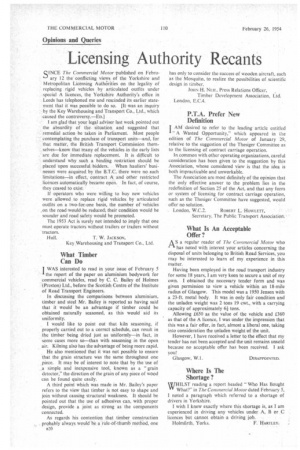Licensing Authority Recants
Page 54

If you've noticed an error in this article please click here to report it so we can fix it.
3INCE The Commercial Motor -published on February 12 the conflicting views of the Yorkshire and Metropolitan Licensing Authorities on the legality of
replacing rigid vehicles by articulated outfits under special A licences, the Yorkshire Authority's office in Leeds has telephoned me and rescinded its earlier statement that it was possible to do so. [It was an inquiry by the Key Warehousing and Transport Co., Ltd„ which caused the controversy.—ED.1 I am glad that your legal adviser last week pointed out the absurdity of the situation and suggested that remedial action be taken in Parliament. Most people contemplating the purchase of transport units—and, for that matter, the British Transport Commission themselves—know that many of the vehicles in the early lists are due for immediate replacement. It is difficult to understand why such a binding restriction should be placed upon successful bidders. When hauliers' businesses were acquired by the B.T.C. there were no such limitations—in effect, contract A and other restricted licences automatically became open. In fact, of course, they ceased to exist If operators who were willing to buy new vehicles were allowed to replace rigid vehicles by articulated outfits on a two-for-one basis, the number of vehicles on the road would be reduced, their condition would be sounder and road safety would be promoted.
The 1953 Act is surely not intended to imply that one must operate tractors without trailers or trailers without tractors.
T. W. JACKSON, Key Warehousing and Transport Co., Ltd,
What Timber Can Do I WAS interested to read in your issue of February 5 the report of the paper on aluminium bodywork for .commercial vehicles, read by C. C. Bailey of Holmes (Preston) Ltd., before the Scottish Centre of the Institute of Road Transport Engineers.
In discussing the comparisons between aluminium, timber and steel Mr. Bailey is reported as having said that it would be an advantage if timber could be obtained naturally seasoned, as this would aid its uniformity.
I would like to point out that kiln seasoning, if properly carried out to a correct schedule, can result in the timber being dried just as uniformly—in fact, in some cases more so—than with seasoning in the open air. Kilning also has the advantage of being more rapid. He also mentioned that it was not possible to ensure that the grain structure was the same throughout one piece. It may be of interest to note that by the use of .a simple and inexpensive tool, known as a "grain detector," the direction of the grain of any piece of wood can be found quite easily.
A third point which was made in Mr. Bailey's paper refers to the view that timber is not easy to shape and join without causing structural weakness. It should be pointed out that the use of adhesives can, with proper design, provide a joint as strong as the components connected.
As regards his contention that timber construction probably always would be a rule-of:thumb metliod, one B20 has only to consider the success of wooden aircraft, such as the Mosquito, to realize the possibilities of scientific design in timber.
JOHN H. Nem, Press Relations Officer, Timber Development Association, Ltd. London, E.C.4.
P.T.A. Prefer New Definition
AM desired to refer to the leading article entitled I " A Wasted Opportunity," which appeared in the edition of The Commercial Motor of January 29, relative to the suggestion of the Thesiger Committee as to the licensing of contract carriage operation.
In common with other operating organizations, careful consideration has been given to the suggestion by this Association, whose considered view is that the idea is both impracticable and unworkable.
The Association are most definitely of the opinion that the only effective answer to the problem lies in the redefinition of Section 25 of the Act, and that any form or system oflicensing for contract carriage operation, such as the Thesiger Committee have suggested, would offer no solution.
London. W.C.2. ROBERT L. HOWLETT, Secretary, The Public Transport Association..
What Is An Acceptable Offer ?
A S a regular reader of The Commercial Motor who 1-1has noted with interest your articles concerning the disposal of units belonging to British Road Services, you may be interested to learn of my experience in this matter.
Having been employed in the road transport industry for some 18 years, I am very keen to secure a unit of my own. I obtained the necessary tender form and was given permission to view a vehicle within an 18-mile radius of Glasgow. This model was a 1950 Jensen with a 23-ft. metal body. It was in only fair condition and the unladen weight was 2 tons 19 cwt., with a carrying capacity of approximately 6i tons.
Allowing £650 as the value of the vehicle and £360 as that of the A licence, I was under the impression that this was a fair offer, in fact, almost a liberal one, taking into consideration the unladen weight of the unit.
However, 1 have received a letter to the effect that my tender has not been accepted and the unit remains unsold because no acceptable offer has been received. I ask you!
Glasgow, W.I. DISAPPOINTED.
Where Is The Shortage ?
WHILST reading a report headed "Who Has Bought What?" in The Commercial Motor dated February 5, I noted a paragraph which referred to a shortage of drivers in Yorkshire.
I wish I knew exactly where this shortage is, as I am experienced in driving any vehicles under A, B or .0 licences but cannot obtain a driving job.
Holmfirth. Yorks. F. HARnEv4
































































































































































































